
JANE BURN – POETRY AS HARD GRAFT, INSPIRATION, REACTION OR EXPERIMENT?
I interviewed poet & artist Jane Burn who won the Michael Marks Environmental Poet of the Year 2023-24 with A Thousand Miles from the Sea.
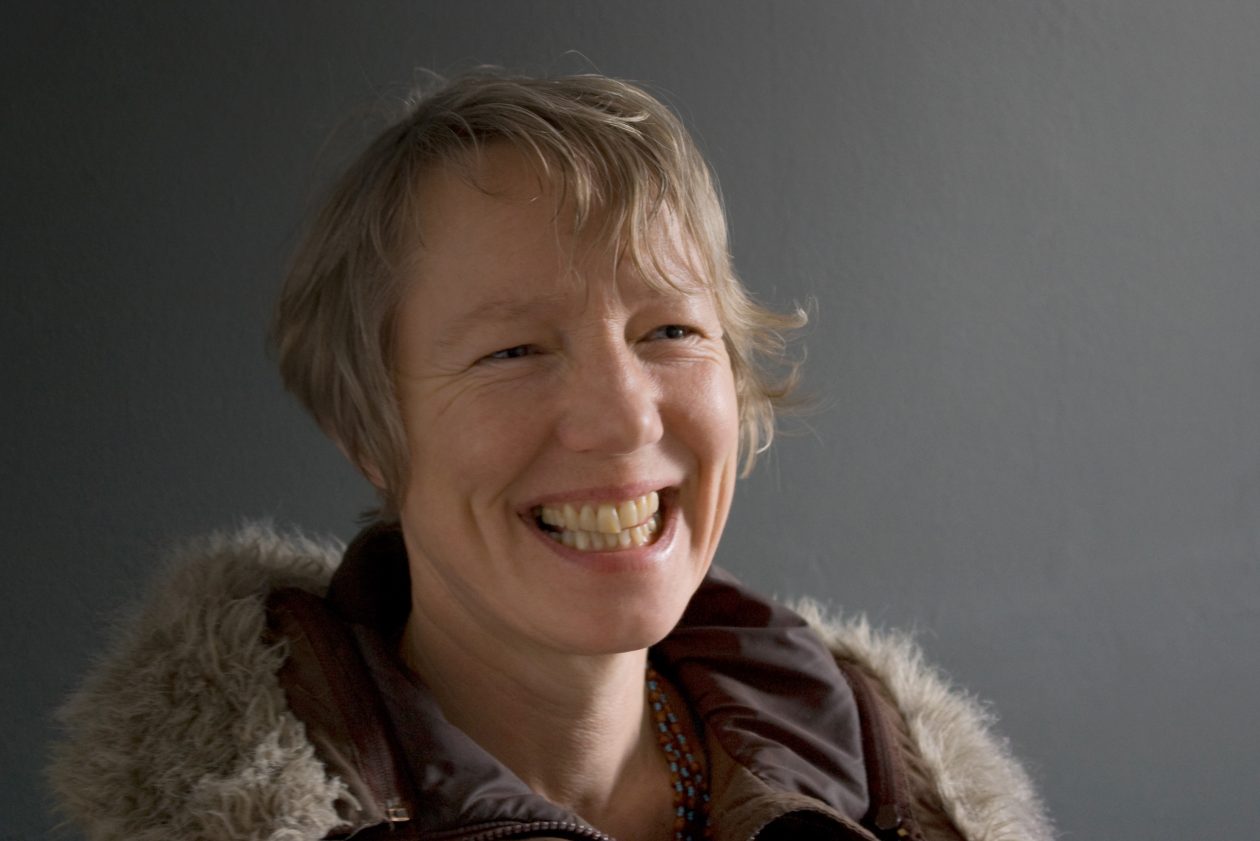
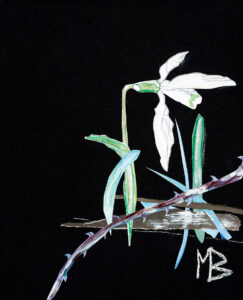
In part two of her interview, artist and environmentalist Mandy Burton talks about what she’s learned from working with young people, her writing, and how she’s overcome personal setbacks.
Leslie: What have you learned from your work to engage young people?
Mandy: I do hope to connect with young people through my writing. Engaging young people through community art is tough, you have to please the funders, the managers and users of the venue where the work will be sited, and inspire and teach the group. All whilst keeping to deadlines and within budget. After moving South, I didn’t have the energy to establish myself as an artist here.
Living with a bunch of young people for seven years at the Housing Coop, taught me much, reminding me of how tough ‘growing up’ can be. I was a difficult teenager, depressive, angry and lacking confidence, so I mostly just tried to love them, though showing that wasn’t easy. I felt I had to be subtle, so they probably didn’t even notice. It’s painful watching young people desperate to ‘fit in’ to a cultural norm that is bullshit.
The best thing about studying fine art, was learning to have confidence in my ideas, developing the skills to nurture my own beliefs and thoughts, though this is an on-going process. As humans, we are so easily led it makes us vulnerable to control, and whilst people are set against each other and made to feel not good enough, we are easy to manipulate.
Leslie: In your experience, what makes community art, including your puppet theatre, work well?
Mandy: For me, community art has been about creating a sense of belonging, to a place or group. Alienation is, I think at the root of most mental health issues. But it needs much more than a sculpture to fix that.
The Puppet theatre I was involved with, Music from the Moon, bridged cultural divides in the most amazing way, particularly in Greenland. After our final performance there an elderly man came up to the stage, he actually cried and said (with translation) it was the first time he’d seen a show that used his native language and stories. I would love to go back one day. Maybe as a story teller.
Leslie: In what ways has your deafness been important for your creative and personal development?
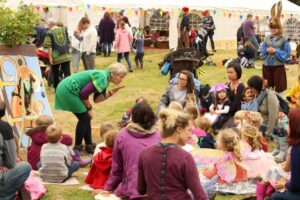
Mandy: My deafness in one ear made teaching large groups of young children very challenging as I couldn’t always hear them. I also have tinnitus, so a hearing aid won’t help, but perhaps explaining this, and asking children to talk quietly, and to speak up when asking me something would be the solution.
Leslie: Which have been your most important experiences as an artist in terms of support and encouragement you’ve received? What barriers have you had to overcome?
Mandy: Peter Hicks, a fantastic North Yorkshire painter, led a small, but rigorous Art Foundation course, he made it possible for me to do O/A Levels and foundation over two years. I will always be grateful to him.
I used to be overwhelmed by the academic side of the art world, the language and politics. Writing my novel is really helping. Although I’m still working on grammar and many other rules, I’m hopeful that imagination and storytelling make up for this!
During my degree studies, my first year’s work (ten, life-size figurative collages) disappeared without trace. A member of staff offered to store them for me, then couldn’t remember anything about it, even denying making the offer. I didn’t talk about this for years. It stopped me painting and instead I wrote poetry that I performed at live events using simple props. My tutor, who wanted to give me a first, said I was a ‘master’ of performance. In the end I was awarded a second, to head off complaints that our friendship was ‘favouritism’, but I still carry his words and encouragement with me. And without the mysterious disappearance of my paintings, perhaps I would never have discovered my love of writing. Another benefit is that when I’ve finished my story and its sequel, I want to re-create the drawings I ‘lost.’ They were called ‘pushing’, and were about being attacked. I will create a new series called ‘pulling,’ about drawing in and sharing love.
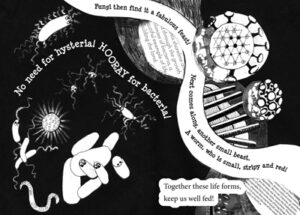
The project that got me writing again was The Loveliest Loo. It came about while I was at the Housing Co-op. I drew the name of a two-year-old from the Secret-Santa hat, and made him a picture book, counting the creatures he would see every day. The director of the Low Impact Living Initiative saw it and asked me to create a book for kids, either about compost or composting toilets. There were several books already about compost and as an advocate of composting toilets, and with great delight, I spent the next year creating The Loveliest Loo – first the story in rhyme then the illustrations. An actor friend taught me to ‘perform’ the story, which I have done at festivals. It’s great fun. This got me going with writing, so many thanks to Dave Darby of lowimpact.org
Leslie: Tell me about the novel you’re writing.
Mandy: The Colour of Things is its title. The underlying theme is connection, and what happens when we become disconnected, from ourselves, from each other and from the natural world.
The main character is Ena, who lives in Pembrokeshire with her mum. The story begins two weeks before Ena’s thirteenth birthday. Finally allowed to walk to Grandma’s on her own, she chooses to go the coast way, instead of through town like usual. En route, Ena plays daredevil by walking along an ancient wall beside a sheer cliff. Ena slips and drops her ‘fancy’ phone – her twelfth birthday present from Dad. The phone, not only stored the images created by Ena, but had caused a massive row between her parents. Shortly afterwards, Dad went missing…
All the characters in my story have obsessions. Grandma, from Northern Ireland, is a botanical illustrator and amateur anthropologist. Mum, born in Wales, is a costumier and is fascinated by the way garments disguise and protect us, and the stories fabrics tell. Dad is a geologist from East Africa. Ena loves magnifying glasses, microscopes, telescopes and creatures that migrate.
Leslie: As a creative person, how do ideas come to you and how do your work them up into a finished artwork?
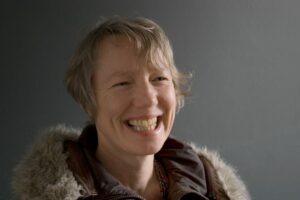
Mandy: I am an obsessive; my obsessions are learning from the natural world, and encouraging creativity / imagining how we might live together, happily, in the future. Lying in bed before sleep, or early in the morning, I imagine the scenes of my story, like a film or play. It’s a great antidote to the horrors constantly streamed to us by the ‘news’.
I don’t write as much as I would like to, as my day job is a P.A for vulnerable people. Also, I need to stake out time to be with my partner and Mum. Writing has its place, and ‘real life’ is just as important .
Next week I interview librarian Zaberjad Iftikhar about UK multi-culturalism.
ABOUT LESLIE TATE’S BOOKS:

I interviewed poet & artist Jane Burn who won the Michael Marks Environmental Poet of the Year 2023-24 with A Thousand Miles from the Sea.

I interviewed ex-broadcaster and poet Polly Oliver about oral and visual poetry, her compositional methods, and learning the Welsh language. Polly says, “I absolutely love

I interviewed Jo Howell who says about herself: “I’ve been a professional photographic artist since I left Uni in 2009. I am a cyanotype specialist.


Poet Tracey Rhys, writer of Teaching a Bird to Sing and winner of the Poetry Archive’s video competition reviews Ways To Be Equally Human. Tracey,
| Cookie | Duration | Description |
|---|---|---|
| cookielawinfo-checkbox-analytics | 11 months | This cookie is set by GDPR Cookie Consent plugin. The cookie is used to store the user consent for the cookies in the category "Analytics". |
| cookielawinfo-checkbox-functional | 11 months | The cookie is set by GDPR cookie consent to record the user consent for the cookies in the category "Functional". |
| cookielawinfo-checkbox-necessary | 11 months | This cookie is set by GDPR Cookie Consent plugin. The cookies is used to store the user consent for the cookies in the category "Necessary". |
| cookielawinfo-checkbox-others | 11 months | This cookie is set by GDPR Cookie Consent plugin. The cookie is used to store the user consent for the cookies in the category "Other. |
| cookielawinfo-checkbox-performance | 11 months | This cookie is set by GDPR Cookie Consent plugin. The cookie is used to store the user consent for the cookies in the category "Performance". |
| viewed_cookie_policy | 11 months | The cookie is set by the GDPR Cookie Consent plugin and is used to store whether or not user has consented to the use of cookies. It does not store any personal data. |